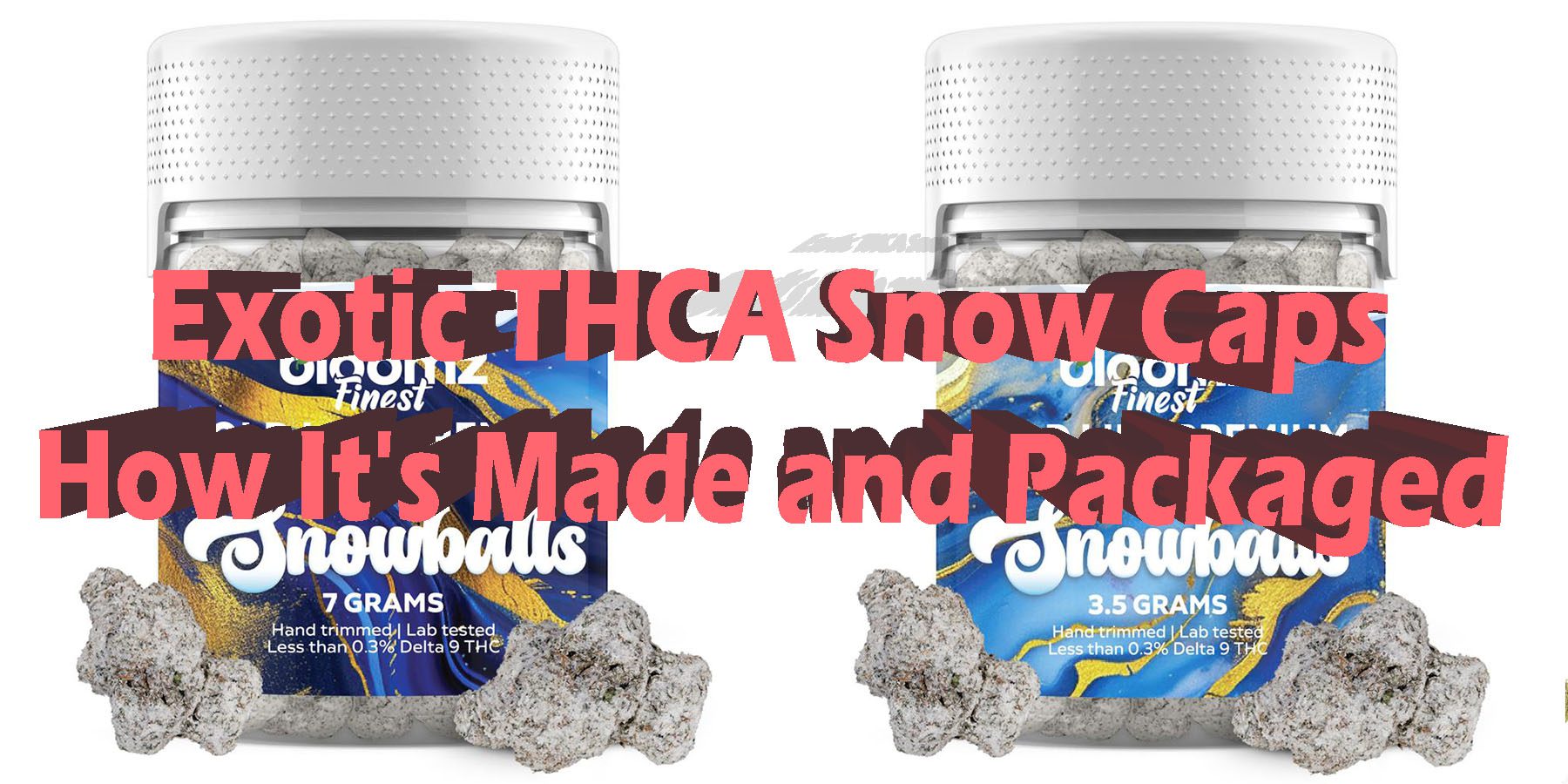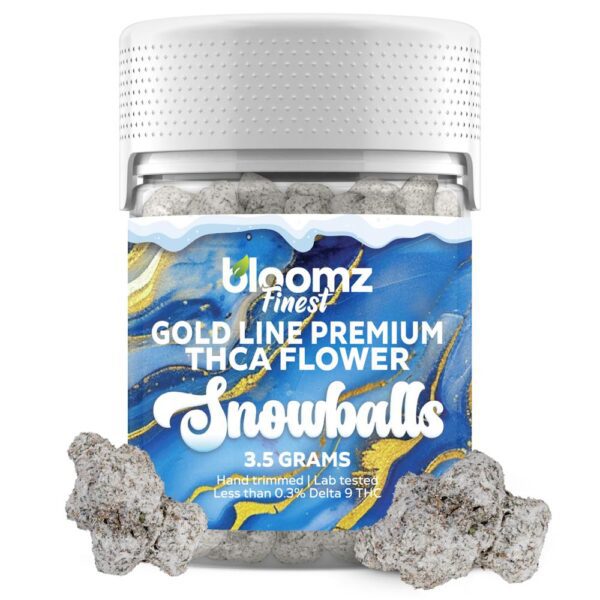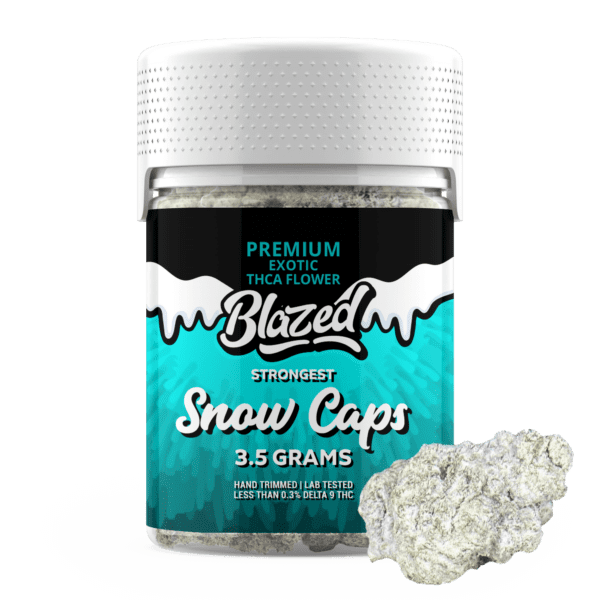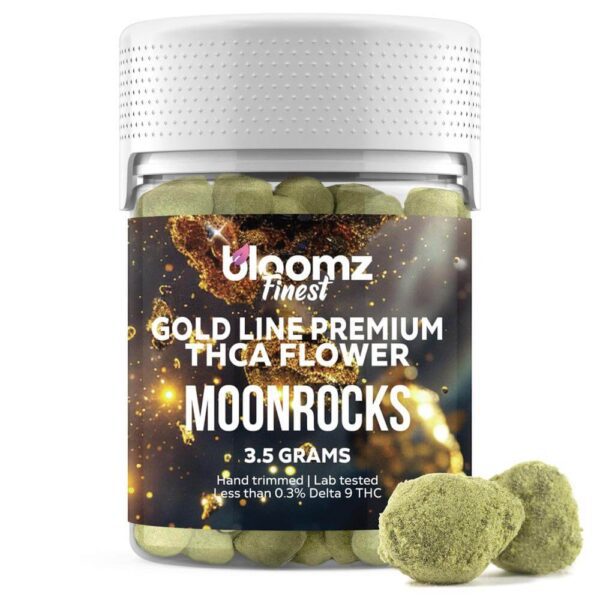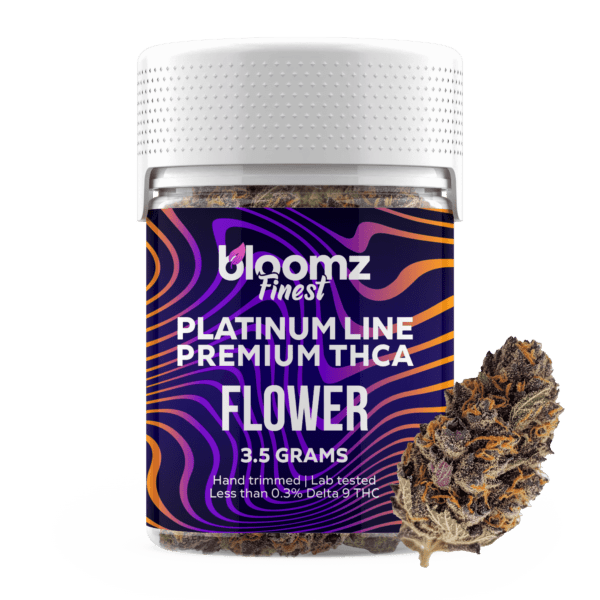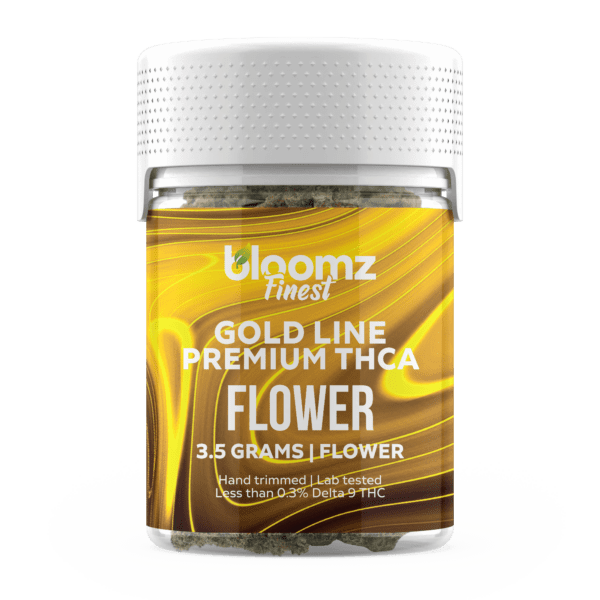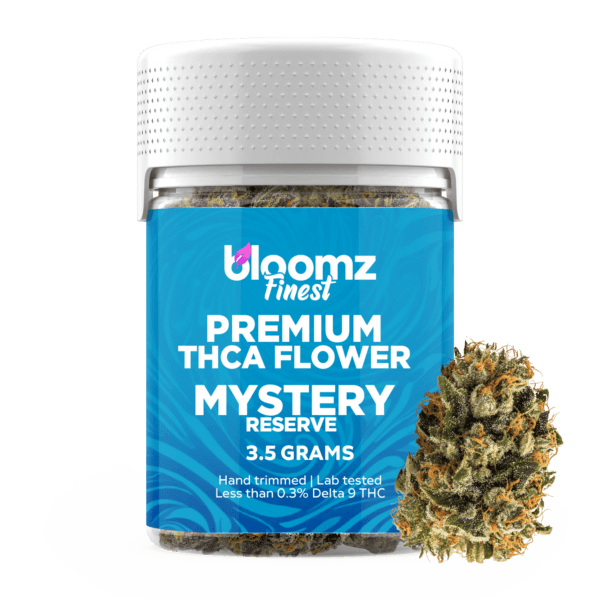Venture into the dazzling world of advanced cannabis creations, and you might encounter a product that looks like miniature, frost-kissed mountain peaks: the Exotic THCA Snow Caps. This intriguing offering takes premium cannabis flower and elevates it, not by fully coating it, but by delicately adorning its tips with a concentrated mantle of pure THCA isolate.
The result is visually striking and packs a potent punch precisely where it’s applied. It’s a marriage of nature’s beauty and laboratory precision, designed to capture attention and deliver intensity. But how is this specific effect achieved? What intricate steps transform a beautiful bud into a selectively frosted marvel? Let’s embark on the detailed journey behind the making and packaging of these unique Exotic THCA Snow Caps.
TO BUY THCA SNOW CAPS CLICK HERE
Recommended products
A Quick Insight into What THCA Snow Caps are
The foundation is “Indoor or Exotic” flower – cannabis strains prized for their unique lineage, often stemming from rare landraces or innovative crossbreeding. These strains distinguish themselves through uncommon terpene profiles that yield distinctive aromas and flavors (think complex fruit medleys, pungent fuel notes, or sweet, dessert-like scents) and striking visual traits like unusual colors or exceptionally frosty appearances. Grown with care, often indoors to perfect their expression, exotic flower represents a connoisseur’s choice even before any enhancement.
Building upon this premium base is the “THCA Snow Cap” treatment. This involves meticulously coating the exotic flower buds with a layer of highly refined THCA isolate. THCA (Tetrahydrocannabinolic Acid) is the non-psychoactive precursor cannabinoid that converts to Delta-9 THC upon heating, delivering potent effects. The isolate form is THCA purified to a crystalline powder, often exceeding 95% concentration. This frosty coating dramatically elevates the total potential THC content of the product, pushing it far beyond the levels naturally achievable in flower alone, while ensuring legal compliance as hemp (≤ 0.3% Delta-9 THC) prior to use.
An Exotic THCA Snow Cap, therefore, is a meticulously crafted product marrying the unique sensory appeal of a specific exotic cannabis strain with the sheer potency boost provided by THCA isolate. It aims to deliver a multi-layered experience: the user first encounters the distinct aroma and visual signatures of the rare base flower, followed by the significantly intensified effects courtesy of the isolate coating. This synergy targets consumers seeking the ultimate combination of nuanced flavor, captivating aroma, and exceptionally powerful potential for bliss and relaxation.
This product category sits at the intersection of artisanal flower cultivation and advanced concentrate technology. It’s often produced by craft growers or specialized manufacturers who understand both how to cultivate exceptional exotic hemp flower and how to safely produce and apply high-purity THCA isolate. Exotic THCA Snow Caps represent a deliberate effort to create a “best-of-both-worlds” scenario for users who refuse to choose between unique terpene profiles and maximized potency, offering a truly elevated and memorable cannabis encounter.
What is Initially Needed to Make Exotic THCA Snow Caps?
The creation of genuine Exotic THCA Snow Caps demands a sophisticated integration of high-level indoor cultivation, advanced cannabinoid isolation science, and a final, delicate application technique. It requires sourcing or producing two distinct, premium components and possessing the skill and equipment to combine them with precision. Mediocrity in either the base flower or the isolate, or clumsiness in the application, will result in a product that fails to meet the “Snow Cap” standard.
For Component 1: The Premium Exotic THCA Flower Base:
Elite Genetics with Suitable Structure: The starting point must be exceptional indoor-grown flower. Key characteristics include:
High THCA & Terpene Content: The base flower needs its own significant potency and a rich terpene profile to define the product’s aroma and underlying experience.
Well-Defined Bud Structure: Ideally, strains that produce somewhat conical or distinctively peaked buds (“crowns”) are preferred, as these shapes lend themselves perfectly to the “capping” aesthetic. Density is still important for overall quality.
Visual Appeal: The color and structure of the exotic THCA flower below the cap are part of the final presentation.
State-of-the-Art Indoor Cultivation Facility: The environment where the base flower is grown must be capable of producing top-tier quality:
Immaculate, fully light-proof, and environmentally sealed grow rooms.
High-performance horticultural lighting (typically advanced LEDs).
Precision climate control systems (HVAC-D) managing temperature, humidity, and VPD.
Robust air filtration (HEPA), circulation, and odor control (carbon scrubbing).
Optimized growing systems (hydroponics, soilless, indoor living soil)
Purified water source (Reverse Osmosis is standard).
Expert Cultivation Team: Growers skilled in advanced indoor techniques capable of nurturing plants to express their full genetic potential, resulting in dense, potent, terpene-rich THCA Snow Caps flower with the desired structure, perfectly dried and cured.
Recommended products
For Component 2: The High-Purity THCA Isolate Cap:
Quality Cannabis Biomass: Suitable starting material (trim, small buds, or whole flower) rich in THCA is needed for efficient extraction and isolation.
Professional Extraction Setup: Commercial-grade equipment for primary cannabinoid extraction (e.g., closed-loop BHO, cold ethanol systems, supercritical CO2). Safety and efficiency are paramount.
Advanced Refinement & Isolation Laboratory: This requires specialized equipment and expertise beyond basic extraction:
Winterization/Filtration systems (to remove fats/waxes).
Solvent recovery apparatus (rotary evaporators, falling film evaporators).
Isolation Technology: Crucially, methods to achieve >99% pure THCA crystals, such as:
Controlled Crystallization: Using reactors with precise temperature control and specific solvents (pentane, heptane, etc.) to precipitate THCA crystals, followed by vacuum filtration and purging in vacuum ovens.
Chromatography: Employing flash chromatography or preparative HPLC for highly selective separation and purification of THCA.
Skilled Extraction Chemists/Technicians: Individuals possessing expertise in chemical separation techniques, solvent handling, purification protocols, and operating sophisticated lab equipment safely and effectively.
Analytical Testing Resources: Access to reliable third-party or validated in-house laboratory testing (HPLC) is essential to confirm the isolate’s purity (target >99% THCA) and, critically, to verify the absence of unsafe levels of residual solvents.
For the Capping Process:
Precise Application Methodology & SOP: A clearly defined, repeatable procedure is needed to apply the isolate only to the designated tip or crown area of the bud. This requires dexterity and precision, unlike coating the entire bud. The SOP must detail every step to ensure consistency.
Controlled & Clean Application Station: The capping must occur in a clean, dedicated area free from contaminants, with stable temperature and humidity to prevent the isolate from clumping or degrading.
Binding Agent & Application Tools (Optional but Likely): To ensure the isolate adheres specifically to the tip, a minimal amount of a binding agent (e.g., cannabis-derived terpenes, pure distillate) is likely needed. Specialized tools (like fine brushes or micro-sprayers) might be used to apply the binder only to the target cap area before gently dipping or rolling that specific part in the isolate. Precision is key to avoid smudging or coating the entire THCA bud.
Recommended products
Understanding the Entire THCA Snow Caps Process
Crafting Exotic and Indoor THCA Snow Caps is a meticulous, multi-stage process demanding excellence in both cultivation and post-harvest modification. It begins with producing truly premium flower, concurrently creating ultra-pure THCA isolate, and culminates in a delicate, artistic application that gives the product its signature look and concentrated potency boost. Each phase below requires specialized skills and unwavering attention to detail:
Cultivating the Premium Base Flower: The journey starts with growing exceptional quality indoor cannabis THCA flower, often an “exotic” strain chosen for its structure, terpene profile, and visual appeal. This involves the full meticulous indoor cultivation process:
Starting with elite genetics (seeds or clones).
Nurturing plants through vegetative growth under optimized light, climate, and nutrient conditions.
Inducing and managing the flowering cycle with precision environmental control to maximize bud density, resin production (rich in THCA), and terpene expression.
Harvesting at peak trichome maturity.
Performing a careful hand-trim to preserve bud structure and trichomes.
Executing a slow, controlled dry to preserve volatile compounds.
Patiently curing the flower in airtight containers (often glass) for weeks or months to achieve optimal smoothness, aroma, and flavor. The flower must be perfectly cured before proceeding.
Extracting Crude Cannabis Oil: Concurrently or separately, cannabis biomass (trim, smaller buds, or specifically grown material) is processed to extract cannabinoids. Using methods like BHO, Ethanol, or CO2 extraction, the goal is to efficiently pull the target compounds from the plant material into a concentrated crude oil form.
Refining and Isolating Pure THCA: This is where laboratory precision becomes paramount. The crude extract undergoes several purification steps:
Winterization: Dissolving the crude oil in cold ethanol causes undesirable fats, waxes, and lipids to precipitate out, which are then removed via filtration.
Solvent Recovery: The ethanol (or other primary extraction solvent) is removed, typically using rotary evaporators or falling film systems.
Isolation: The refined oil concentrate is then processed to isolate THCA. Common methods include:
Crystallization:Dissolving the concentrate in a specific non-polar solvent (like pentane or heptane) and manipulating temperature (often cooling) and concentration allows the THCA molecules, which are crystalline in nature, to precipitate out, forming crystals. Impurities tend to remain dissolved in the solvent. The crystals are collected via filtration, washed with cold solvent, and then carefully dried under vacuum to remove all residual solvent traces. This process might be repeated (“recrystallization”) to achieve higher purity.
Chromatography: Using advanced techniques like preparative HPLC, the extract is passed through a column packed with specialized material. Different compounds travel through the column at different speeds based on their affinity to the material, allowing for the collection of highly pure fractions of THCA.
The end goal is a fine, white crystalline powder that is 99%+ pure THCA.
Rigorous Quality Control on Both Components: Before combining, both the cured exotic flower and the finalized THCA isolate powder undergo separate, thorough testing by an accredited third-party lab.
Flower Testing: Confirms potency (THCA, Delta-9 THC compliance), terpene profile, and safety (pesticides, microbes, heavy metals).
Isolate Testing: Critically verifies THCA purity (ideally >99%) and screens for residual solvents used during extraction and isolation, ensuring they are below safety action levels.
Preparing the Components for Coating: Selected buds of the premium cured flower, meeting size and structure criteria, are handled carefully. The pure THCA isolate powder is ensured to be of a fine, consistent particle size, free of clumps.
The Coating Process – Applying the “Snow”: This delicate step requires precision and care:
Method Selection: The most common approach involves gently applying the isolate to the flower. This might be:
Simple Rolling/Dusting: Gently rolling or tumbling the buds in a container of the isolate powder. Adherence might be less uniform with this method alone.
Binder-Assisted Application: Applying a very fine mist of a carefully chosen binding agent (like cannabis-derived terpenes to complement the flower’s profile, or a minuscule amount of high-purity cannabis distillate) to the bud surface immediately before rolling/dusting in the isolate. The binder helps the powder stick more effectively and evenly but must be used extremely sparingly to avoid creating a sticky or wet texture.
Electrostatic Coating (Advanced): Some advanced operations might explore electrostatic equipment that charges the isolate particles, causing them to adhere more uniformly to the grounded flower surface, though this is less common.
Execution: Regardless of method, the application is done carefully in a clean environment to ensure an even, aesthetically pleasing coating that covers the bud surface without significant clumping or damage to the underlying flower structure.
Final Quality Inspection: Once coated, the finished Exotic THCA Snowballs are visually inspected. Checks are made for coating uniformity, adequate coverage, absence of discoloration or contamination, and confirmation that the underlying bud structure remains intact. Any poorly coated or damaged pieces are typically removed.
Careful Packaging: The finished Snowballs are delicate. They must be packaged gently and promptly into containers designed to protect both the flower structure and the easily dislodged isolate coating.
Why is Each Step Vital to the THCA Snow Caps Making Process Anyways?
Creating a genuine Exotic and Indoor THCA Snow Cap isn’t merely about adding potency; it’s about achieving a specific, high-quality aesthetic and experience that relies on the successful integration of multiple complex processes. Each stage, from growing the flower to applying the final frosty touch, is a critical checkpoint. A shortcut or failure at any point diminishes the final product, betraying the “Snow Cap” promise of premium quality and unique presentation. Here’s a breakdown of why every step holds vital importance:
Premium Base Flower Cultivation: The quality and structure of the underlying exotic flower are paramount. It provides the visual foundation, the essential terpene profile (aroma/flavor), and the physical structure upon which the cap rests. A poorly grown or structured bud cannot be transformed into a premium THCA Snow Caps.
Quality Biomass & Extraction (for Isolate): Starting with suitable biomass and using clean, efficient extraction methods ensures a higher quality crude oil, making the subsequent isolation process more efficient and reducing the likelihood of concentrating unwanted impurities.
Meticulous Isolate Refinement & Purification: Achieving >99% THCA purity is vital for maximizing the potency boost in the cap. Even more critical is the removal of residual solvents used during isolation; failure here results in an unsafe product. Purity defines the quality of the “snow.”
Rigorous Quality Control & Testing: Independent lab testing of both components separately, and potentially the final product, is essential for verifying potency claims, ensuring regulatory compliance (Delta-9 THC limits), and guaranteeing consumer safety by screening for contaminants like pesticides, microbials, and residual solvents. It provides necessary validation.
Careful Component Preparation: Selecting well-formed buds ensures the “cap” has a suitable peak to adhere to. Having fine, consistent isolate powder allows for a smooth, even coating rather than a clumpy or sparse one. Preparation enables proper application.
Precision Capping Technique: This is the defining step for the product type. The ability to apply the isolate only to the tip, cleanly and uniformly, creates the signature THCA Snow Cap look. Sloppy application results in a product that isn’t a Snow Cap and lacks the intended aesthetic appeal.
Perfect Drying & Curing (Base Flower): The base flower must be perfectly dried and cured before capping. Applying isolate to improperly dried flower risks trapping moisture, leading to mold and degradation. The cure develops the underlying terpene profile that the isolate enhance
Gentle Handling: Throughout the process, but especially during capping and packaging, gentle handling is crucial to avoid damaging the delicate flower structure or dislodging the carefully applied isolate cap.
Appropriate Protective Packaging: Packaging must prevent the Snow Cap from being crushed and minimize friction that could rub off the isolate tip, preserving the product’s unique form and potency until it reaches the consumer.
Basically, the quality of an Exotic THCA Snow Cap is a direct result of cumulative excellence maintained across distinct domains of cultivation, chemical processing, and artisanal application.
How is the Packaging Itself for Exotic THCA Snow Caps Made and Designed?
Packaging for Exotic THCA Snow Caps requires careful consideration, balancing the need for preservation and compliance with the desire to protect and often showcase the unique “capped” appearance of the product. Similar to Snowballs, the priary challenge is safeguarding the delicate THCA isolate application, specifically on the tips, while also protecting the underlying premium flower. Rigid containers are generally preferred to prevent crushing and minimize abrasion against the capped peaks. Design choices often reflect the premium, visually distinct nature of Snow Caps.
Glass Jars
Manufactured by melting and molding silica, soda ash, and limestone, glass jars offer superior rigidity and a premium feel, making them an excellent choice for protecting delicate THCA Snow Caps. Brands typically select high-quality glass, potentially with thick walls, to prevent breakage and provide a substantial presentation. Clear glass is highly favored as it allows consumers to see the distinct “snow-capped” effect, highlighting the product’s unique visual appeal before purchase. Achieving a truly airtight seal is critical; this requires well-engineered lids (often metal or premium plastic/wood) paired with high-performance, inert liners (like PTFE or specialized foam) to prevent moisture exchange (which could clump the isolate) and oxygen ingress (which degrades cannabinoids and terpenes).
The inherent rigidity of glass is paramount for Snow Caps, preventing the buds from being compressed and the caps from being crushed or flattened during handling and transport. The smooth interior surface minimizes friction, reducing the chance of the isolate cap rubbing off compared to flexible packaging. Careful placement of the Snow Caps within the jar (e.g., standing upright if possible, or gently packed to prevent excessive movement) further aids preservation of the cap. Glass packaging strongly reinforces the premium, connoisseur positioning of Exotic THCA Snow Caps.
Pros:
Excellent physical protection prevents crushing/damaging the cap.
Inert material perfectly preserves base flower terpenes and doesn’t react with isolate.
Clear glass superbly showcases the unique “Snow Cap” visual appeal.
Capable of achieving a superior airtight seal with quality components.
Premium look and feel enhances perceived value.
Offers UV protection options if colored glass is chosen (though less common if visibility is desired).
Cons:
Higher packaging cost.
Breakable and heavier.
Clear glass provides no UV protection.
Requires careful packing within the jar to prevent buds from tumbling and damaging caps.
Recommended products
Biodegradable Jars
These containers are molded from plant-derived plastics (like PLA) or sustainable composites (like bamboo/wood fiber). They offer good structural rigidity, providing necessary protection against crushing for the THCA Snow Cap buds and their delicate tips. Most biodegradable materials are opaque, offering inherent protection from UV light degradation. Design focuses on achieving a reliable seal using appropriate lid mechanisms and liners to maintain freshness and protect the isolate from moisture.
The rigidity is a major advantage for protecting the Snow Caps’ form. While the opacity prevents consumers from viewing the unique appearance directly, it does provide consistent light protection. The internal surface might have slightly more texture than glass, potentially causing minor abrasion on the caps if the buds move significantly within the jar. Brands using biodegradable jars often leverage the eco-conscious angle, presenting a high-tech product within sustainable packaging. Ensuring a high-quality, truly airtight seal is crucial for long-term preservation.
Pros:
Good physical protection due to rigid structure.
Aligns with sustainability initiatives.
Opacity provides inherent UV light protection.
Can be designed with effective airtight seals.
Cons:
Hides the unique visual aspect of the Snow Cap.
Internal surface texture might cause slightly more friction than glass.
Seal effectiveness and long-term barrier properties can vary.
Often more expensive than conventional plastics.
Specific composting conditions usually required for biodegradation.
Mylar Bags
Mylar bags are flexible pouches made from laminated layers, typically including PET, aluminum foil, and a PE sealant layer. They offer excellent barriers against light, oxygen, and moisture due to the foil layer, and provide ample space for branding. However, their flexibility is a significant drawback for packaging delicate, three-dimensional products like THCA Snow Caps.
While the barrier properties are excellent for preserving overall freshness if well-sealed, the lack of rigidity makes Mylar bags less ideal for Snow Caps. During handling, shipping, and display, the flexible bag walls can press against the buds, potentially crushing the flower structure and, more critically, rubbing against the isolate-coated tips. This friction can easily dislodge or smudge the “cap,” ruining the distinctive aesthetic and potentially leading to uneven potency if significant amounts of isolate are lost to the bag walls. While cheaper and lighter, the risk of damaging the product’s unique feature makes Mylar a less suitable option compared to rigid jars for premium THCA Snow Caps.
Pros:
Excellent light, oxygen, and moisture barrier.
Lightweight and space-efficient.
Large surface area for branding/information.
Can incorporate required CR features.
Cons:
Poor physical protection; high risk of crushing buds and damaging caps.
High potential for isolate cap to rub off or smudge due to friction.
Less premium perception for such a visually distinct product.
Difficult to recycle.
For Retailers and Consumers: Ways to Identify Properly Made THCA Snow Caps
Identifying authentic, high-quality Exotic/Indoor THCA Snow Caps involves more than just recognizing the white tip; it requires assessing the quality of the base flower, the purity and application of the isolate cap, and the overall execution of this unique product concept. As Snow Caps represent a premium, intricate product, both retailers selecting top-shelf inventory and consumers seeking a potent and visually appealing experience need to know the signs of meticulous craftsmanship versus subpar imitation.
How Retailers Can Identify Properly Made THCA Snow Caps
Retailers aiming to stock genuine, high-quality THCA Snow Caps should employ a rigorous vetting process, focusing on source credibility, verifiable data, and careful sensory evaluation. And so, these would be key identification strategies for retailers:
Confirm Source Expertise: Partner with brands or cultivators demonstrably skilled in both premium indoor flower production and high-purity cannabinoid isolation. Ask detailed questions about their capping process, sourcing of flower/isolate, and quality control measures. Look for transparency and a commitment to quality in both aspects.
Scrutinize Comprehensive COAs: Insist on batch-specific lab reports for the final product. Verify:
Potency: Exceptionally high THCA levels, compliant Delta-9 THC.
Safety: Passing results for pesticides, microbials, heavy metals (ideally from base flower test).
Residual Solvents: Clean results confirming safe removal of solvents used in isolate production are absolutely critical. Lack of this test is a major red flag.
Perform Detailed Sensory & Visual Inspections:
Sight: Look for a distinct, clearly defined “cap” of fine, white crystalline powder applied precisely to the tip or crown of a well-structured, visibly high-quality bud. The application line should be relatively clean, not messy or smudged down the sides. Avoid products where the “cap” looks clumpy, discolored, sparse, or like the whole bud was haphazardly rolled.
Smell (Nose): The aroma should be dominated by the terpenes of the underlying exotic flower. Pure THCA isolate is odorless. Any chemical or solvent smell is unacceptable.
Handling/Feel: Gently handled, the cap should appear well-adhered, though minimal shedding might occur. The flower beneath should feel properly cured. The overall impression should be one of careful construction.
Evaluate Consistency: Within a single container or batch, the capping application should be reasonably consistent across buds in terms of coverage and definition. Significant inconsistency suggests poor process control.
Assess Packaging Choice: Favor products packaged in rigid containers (ideally glass jars) that protect the THCA Snow Caps from physical damage and minimize friction against the capped tips.
How Consumers Can Identify Properly Made Exotic THCA Snow Caps
Consumers intrigued by the unique appearance and potency of THCA Snow Caps should look for these direct key indicators of quality and safety before purchasing:
Research Brand Reputation & Transparency: Choose brands known for quality indoor flower and, ideally, that provide information about how their Snow Caps are made (e.g., base strain, isolate process). Reputable retailers often curate reliable brands.
Prioritize Visual Confirmation: If possible (e.g., through clear jars), examine the product closely. Look for that distinct “snow-capped peak” effect – a clear visual separation between the white isolate cap and the green/purple flower body. It should look like powder meticulously applied to the tip, not like the whole bud was dunked or haphazardly coated.
Trust Your Nose: The product should smell primarily like high-quality cannabis flower, reflecting the base strain’s terpenes. Avoid products with off-putting chemical or solvent-like odors.
Check for Lab Reports (COAs): Look for QR codes or ask the retailer for access to testing data. Confirm high THCA potency, Delta-9 compliance, and, most importantly, passing results for safety screens, especially residual solvents.
Consider the Packaging: Prefer products in rigid jars (glass is ideal) that protect the delicate structure and allow you to see the product. Be cautious with flexible packaging like Mylar bags, as the caps might be damaged or rubbed off.
Expect a Premium Price: Given the high-quality base flower, pure isolate, and intricate process involved, authentic Exotic THCA Snow Caps are a premium product and will be priced accordingly. Extremely low prices could indicate compromises.
Start Low, Go Slow: Like THCA Snowballs, Snow Caps have significantly boosted potency concentrated in the capped area. Use a much smaller amount than usual for your first experience to gauge the effects.
Crafting Frosty Exotic THCA Snow Caps Really is an Intricate Process!
The creation of Exotic THCA Snow Caps is a remarkable display of precision and patience within the cannabis industry, demanding a harmonious blend of expert cultivation, exacting laboratory refinement, and a final, artistic touch. It elevates premium flower beyond its natural state, adding a concentrated crown of potency that’s as visually striking as it is intense. This meticulous process, from nurturing the perfect bud structure to isolating near-pure THCA and applying it with pinpoint accuracy, reflects a dedication to innovation and quality. Each Snow Cap serves as a tiny monument to the intricate journey combining nature’s best offerings with the careful application of scientific technique, culminating in a truly unique and powerful cannabis experience.
TO BUY THCA SNOW CAPS CLICK HERE
Recommended products
-
THCA Flower – Indoor Exotics – Gold Line
$37.99$69.99 -
THCA Flower – Mystery Reserve
$41.99$79.99 -
Exotic THCA Smalls
$179.99$329.99 -
Exotic THCA Pre-Rolls Gold Line – 3-Pack/6 Pack
$36.99$69.99

